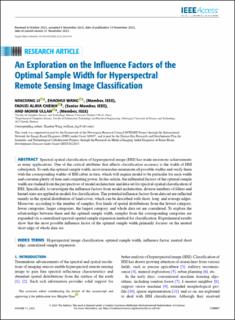| dc.contributor.author | Li, Ningyang | |
| dc.contributor.author | Wang, Zhaohui | |
| dc.contributor.author | Alaya Cheikh, Faouzi | |
| dc.contributor.author | Ullah, Mohib | |
| dc.date.accessioned | 2024-01-16T13:33:35Z | |
| dc.date.available | 2024-01-16T13:33:35Z | |
| dc.date.created | 2023-12-18T09:33:26Z | |
| dc.date.issued | 2023 | |
| dc.identifier.citation | IEEE Access. 2023, 11 128667-128680. | en_US |
| dc.identifier.issn | 2169-3536 | |
| dc.identifier.uri | https://hdl.handle.net/11250/3111881 | |
| dc.description.abstract | Spectral-spatial classification of hyperspectral image (HSI) has made enormous achievements in many applications. One of the critical attributes that affects classification accuracy is the width of HSI cube/patch. To seek the optimal sample width, most researches enumerate all possible widths and verify them with the corresponding widths of HSI cubes in turn, which will require model to be particular for each width and consume plenty of time and computing power. In this article, the influential factors of the optimal sample width are studied from the perspectives of model architecture and data set for spectral-spatial classification of HSI. Specifically, to investigate the influence factors from model architecture, diverse numbers of filters and kernel sizes are applied in models for classification. The potential influence factors from data set are reflected mainly in the spatial distribution of land-cover, which can be described with short, long, and average edges. Moreover, according to the number of samples, five kinds of spatial distributions from the fewest category, fewer categories, larger categories, the largest category, and whole data set are considered. To explore the relationships between them and the optimal sample width, samples from the corresponding categories are expanded via a centralized spectral-spatial sample expansion method for classification. Experimental results show that the most possible influence factor of the optimal sample width primarily focuses on the neutral short edge of whole data set. | en_US |
| dc.language.iso | eng | en_US |
| dc.publisher | IEEE, Institute of Electrical and Electronics Engineers | en_US |
| dc.rights | Attribution-NonCommercial-NoDerivatives 4.0 Internasjonal | * |
| dc.rights.uri | http://creativecommons.org/licenses/by-nc-nd/4.0/deed.no | * |
| dc.title | An Exploration on the Influence Factors of the Optimal Sample Width for Hyperspectral Remote Sensing Image Classification | en_US |
| dc.title.alternative | An Exploration on the Influence Factors of the Optimal Sample Width for Hyperspectral Remote Sensing Image Classification | en_US |
| dc.type | Peer reviewed | en_US |
| dc.type | Journal article | en_US |
| dc.description.version | publishedVersion | en_US |
| dc.source.pagenumber | 128667-128680 | en_US |
| dc.source.volume | 11 | en_US |
| dc.source.journal | IEEE Access | en_US |
| dc.identifier.doi | 10.1109/ACCESS.2023.3332695 | |
| dc.identifier.cristin | 2214649 | |
| cristin.ispublished | true | |
| cristin.fulltext | original | |
| cristin.qualitycode | 1 | |

